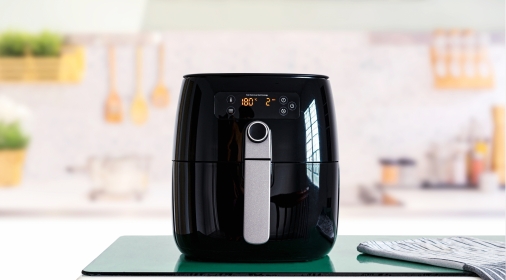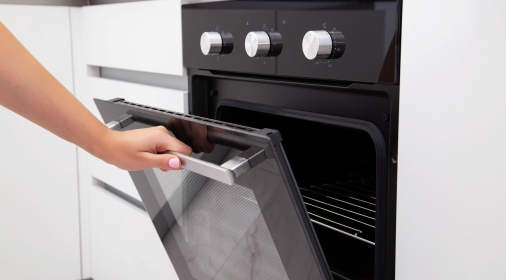Exploding beans and splattered leftovers? Not only do the splatters of food in your microwave smell and look bad, but this build-up could also decrease its efficiency, cause a fire and void your warranty..
Cleaning your microwave doesn’t have to feel like a chore, and you don’t need a cupboard full of fancy products to get it sparkling again. In this step-by-step guide, we’ll walk you through how to clean a microwave with white vinegar, lemon and baking soda – along with the benefits of each method and our expert tips to keep grime at bay!
Page contents
- How to Clean a Microwave with Lemon
- How to Clean a Microwave with White Vinegar
- How to Clean a Microwave Oven with Baking Soda
- Microwave Cleaning FAQs
How to Clean a Microwave with Lemon
Cleaning a microwave with lemon is a natural and effective method to get rid of grease, grime, stubborn stains and odours. Along with their acidity, they also have mild antibacterial properties, making them perfect for tackling surfaces that come into contact with food. Plus, it leaves your microwave smelling refreshingly citrusy. Keep reading for a simple step-by-step guide to getting your microwave looking and smelling clean again.
Benefits of Cleaning with Lemon
- Lemons contain citric acid, which is effective at breaking down grease.
- Lemons are natural and free of harsh chemicals, making them safe to use around children, pets and food.
- Lemons are relatively inexpensive, which makes them a cost-effective alternative to some high–street cleaning products.
What You’ll Need
- 1 lemon
- 1 microwave-safe bowl
- Water
- A sponge or cloth
The Method
- Cut the lemon in half. Squeeze the juice into a microwave-safe bowl, then put the lemon halves into the bowl.
- Fill the bowl with 230ml of cold water.
- Place the bowl in the microwave and put it on high for 3-5 minutes. The water will heat up and create steam, while the lemon juice helps break down grease.
- Once the time is up, keep the microwave door closed for an additional 2-3 minutes. This allows the steam to loosen any dirt or stains inside the microwave.
- Open the microwave door and carefully remove the bowl (it might be hot). Then, use a sponge or cloth to wipe down the interior – don’t forget the roof. The steam should have made it easier to remove any food splatters or stains.
- If your microwave has a turntable, remove it and wash it with soap and water. Finally, wipe the area where the turntable sits.
How to Clean a Microwave with White Vinegar
There are many different methods and products available to clean a microwave, but white vinegar is easy, safe and cheap. Steam cleaning a microwave with white vinegar gets the job done with minimal effort. This is because white vinegar is very acidic, making it a great natural cleaning product that can tackle microwave dirt and grime easily.
Benefits of Cleaning with White Vinegar
- White vinegar is inexpensive to buy from most stores.
- Vinegar contains no harsh chemicals or fumes.
- Vinegar works to remove odours, instead of masking them.
- Vinegar is an environmentally friendly product.
What You’ll Need
- White vinegar
- Microwavable bowl or jug
- Cleaning sponge
- Clean dry cloth
The Method
- Take the microwave–safe bowl or jug and add 500ml of water, followed by 2 tablespoons of white vinegar.
- Place the bowl or jug into the microwave. Then, microwave on full power for 5 minutes – you will notice the liquid beginning to boil.
- Once the 5 minutes is up, leave the microwave door closed for around 3 minutes. Keeping the door closed will trap the steam inside to help loosen the burnt-on food grime.
- Carefully open the microwave door and remove the bowl or jug. The solution will be very hot, so wear a glove or oven mitt. If your microwave has removable parts such as a turntable, remove this too.
- Use the sponge to wipe the inside of the microwave, starting from the roof, down to the sides and door. The grime should wipe away easily due to the steam, however burnt-on grime may require a little more elbow grease.
- Then, wipe the turntable over with the cleaning sponge and dry off with a clean, dry cloth.
- Use the clean cloth to buff the microwave dry, then place all the removable parts back and you’re good to go!
How to Clean a Microwave Oven with Baking Soda
One of the best ways to clean a microwave is with baking soda: another natural and effective method. Both gentle and powerful, its mild abrasiveness makes it great for scrubbing off hardened food splatters without causing any damage. Baking soda is also known for its ability to absorb odours, lift stains and break down grease. Discover how to clean the inside of your microwave with this cleaning powerhouse below.
Benefits of Cleaning with Baking Soda
- Baking soda is a natural deodoriser, so will effectively remove smells from the microwave.
- Baking soda is mildly abrasive, so can help remove stubborn stains without scratching the surface.
- Like lemon and vinegar, baking soda is a safe, chemical-free alternative to high–street cleaning products.
What You’ll Need
- 1 tablespoon of baking soda
- 1 cup of water
- A microwave-safe bowl
- A sponge or cloth
The Method
- In a microwave-safe bowl, combine 1 tablespoon of baking soda with 230ml of water. Stir to dissolve the baking soda.
- Place the bowl in the microwave and heat it on high for 3-5 minutes. The solution will begin to create steam, which helps loosen any food particles and grime inside the microwave.
- After the microwave timer goes off, leave the door closed for 2-3 minutes to let the steam continue working its magic on the dirt and grease.
- Carefully open the microwave door and remove the bowl. The bowl may be hot, so use a tea towel to remove it.
- Use a damp sponge or cloth to wipe down the microwave’s interior, including the roof, walls, floor and turntable. The baking soda will help lift grease and stains, making it easier to clean.
- If your microwave has a turntable, remove it and wash it with warm, soapy water. Wipe down the area where the turntable sits.
- If there are lingering odours in the microwave, you can place a bowl of dry baking soda inside the microwave (while it’s turned off) to absorb any remaining smells.
Microwave Cleaning FAQs
How Often Should you Clean the Microwave?
How often you need to clean your microwave depends on how often it’s used. Microwaves in family homes should be wiped over once a week and then deep cleaned every few weeks. Regularly cleaning your microwave will prevent a build-up of food grime and stains will be easier to remove.
What is the Best Hack for Cleaning a Microwave?
One of the best and most efficient ways to clean your microwave is by harnessing the power of steam. Steam loosens stuck-on grime and food debris, making it easier to wipe away. You can add vinegar or lemon to the water which will act as a natural degreaser and disinfectant, ensuring your microwave is not only clean but also sanitised. Plus, this hack is chemical-free, which means it’s safe to use around food.
What Not to do When Cleaning a Microwave?
To ensure your microwave remains in good condition and functions properly, it’s important to avoid these cleaning blunders:
- Don’t use harsh chemicals – Avoid using harsh chemicals to clean your microwave as they can leave behind harmful residues and unpleasant odours that could contaminate your food.
- Avoid abrasive sponges – Using an abrasive sponge can be tempting when trying to remove stubborn grime in your microwave. However, these sponges can scratch the interior of your microwave, leaving spaces for food particles to accumulate.
- Don’t use excessive water – Microwaves are electrical appliances so it’s important not to use too much water. If you are using the steam cleaning method, only use the recommended amount of water in a microwave–safe container.
- Don’t leave the microwave turned on – Before cleaning your microwave, make sure it is turned off and unplugged. This ensures your safety and prevents the risk of damaging the microwave’s electrical system during cleaning.
Is it Better to Clean a Microwave with Lemon or Vinegar?
When it comes to cleaning your microwave, both lemon and vinegar are effective natural cleaners, but each has its own advantages depending on your preferences and needs. Vinegar is a powerful degreaser, making it perfect for removing food splatters. However, white vinegar does have a strong scent, which can linger once the microwave has been cleaned.
Lemon has a natural, fresh citrus smell, however it’s less effective at removing grease, so may require more scrubbing than white vinegar. Vinegar is better for tough grease and grime, while lemon is better for deodorising and providing a fresh scent. If you prefer a balance of both, combining them can give you the best of both worlds.
How do I get Brown Stains out of my Microwave?
Getting brown stains out of the microwave can be tricky as they are likely to be burnt-on food splatters. However, it’s important to also check if these brown marks are rust. If rust is present in the microwave, it could be time to get a new one. However, if the brown marks are food deposits, then they can be cleaned away using the above methods, such as cleaning the microwave with vinegar, lemon or baking soda.
To avoid brown stains from building up again:
- Use a microwave cover or a microwave-safe plate when reheating food to catch splatters.
- Regularly wipe down the interior of your microwave after use to prevent food particles from sticking.
- Perform a quick clean every few days to keep the microwave in good shape.
How do you get Grease out of the Inside of a Microwave?
In addition to using lemon, vinegar and baking soda to remove grease from the microwave, another tip is to use a grease–removing dish soap. You can apply neat dish soap directly to the grease stain or make a solution with warm water.
We hope our guide has given you the knowledge on how to clean your microwave oven using household products. If you’ve tried these recommended methods and are still struggling with stubborn stains, we offer professional microwave cleaning – as well as Oven cleaning, BBQ cleaning and Hob cleaning. So, if you’re looking for a professional deep clean, contact us today for a free quote!





